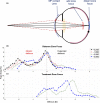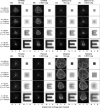Modelling the refractive and imaging impact of multi-zone lenses utilised for myopia control in children's eyes
- PMID: 35170789
- PMCID: PMC9544677
- DOI: 10.1111/opo.12959
Modelling the refractive and imaging impact of multi-zone lenses utilised for myopia control in children's eyes
Abstract
Purpose: To develop an optical model of a child's eye to reveal the impact of target distance and accommodative behaviour on retinal image quality when fitted with multi-zone lenses.
Methods: Pupil size, aberration levels and accommodative lag were adjusted for models viewing stimuli at 400, 100, 33 and 20 cm. Distributions of defocus across the pupil and simulated retinal images were obtained. An equivalent 16-point letter was imaged at near viewing distances, while a 0.00 logMAR (6/6) letter was imaged at 400 cm. Multi-zone lenses included those clinically utilised for myopia control (e.g., dual-focus, multi-segmented and aspherical optics).
Results: Viewing distance adjustments to model spherical aberration (SA) and pupil radius resulted in a model eye with wider defocus distributions at closer viewing distances, especially at 20 cm. The increasing negative SA at near reduced the effective add power of dual-focus lenses, reducing the amount of myopic defocus introduced by the centre-distance, 2-zone design. The negative SA at near largely compensated for the high positive SA introduced by the aspheric lens, removing most myopic defocus when viewing at near. A 0.50 D accommodative lag had little impact on the legibility of typical text (16-point) at the closer viewing distances.
Conclusions: All four multi-zone lenses successfully generated myopic defocus at greater viewing distances, but two failed to introduce significant amounts of myopic defocus at the nearest viewing distance due to the combined effects of pupil miosis and negative SA. Typical 16-point type is easily legible at near even in presence of the multi-zone optics of lenses utilised for myopia control and accommodative lag.
Keywords: aberrations; accommodation; defocus; multi-zone lenses; myopia; simulated retinal image.
© 2022 The Authors. Ophthalmic and Physiological Optics published by John Wiley & Sons Ltd on behalf of College of Optometrists.
Conflict of interest statement
None.
Figures











References
-
- Ding BY, Shih YF, Lin LLK, Hsiao CK, Wang IJ. Myopia among schoolchildren in East Asia and Singapore. Surv Ophthalmol 2017;62:677–97. - PubMed
-
- Jung SK, Lee JH, Kakizaki H, Jee D. Prevalence of myopia and its association with body stature and educational level in 19‐year‐old male conscripts in Seoul, South Korea. Invest Ophthalmol Vis Sci 2012;53:5579–83. - PubMed
-
- Wang TJ, Chiang TH, Wang TH, Lin LL, Shih YF. Changes of the ocular refraction among freshmen in National Taiwan University between 1988 and 2005. Eye (Lond) 2009;23:1168–9. - PubMed
MeSH terms
LinkOut - more resources
Full Text Sources

